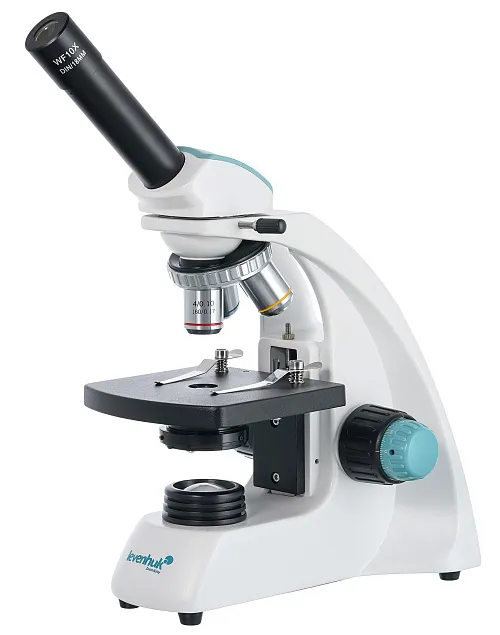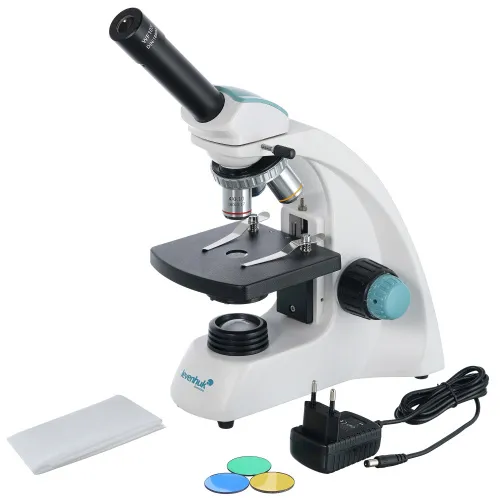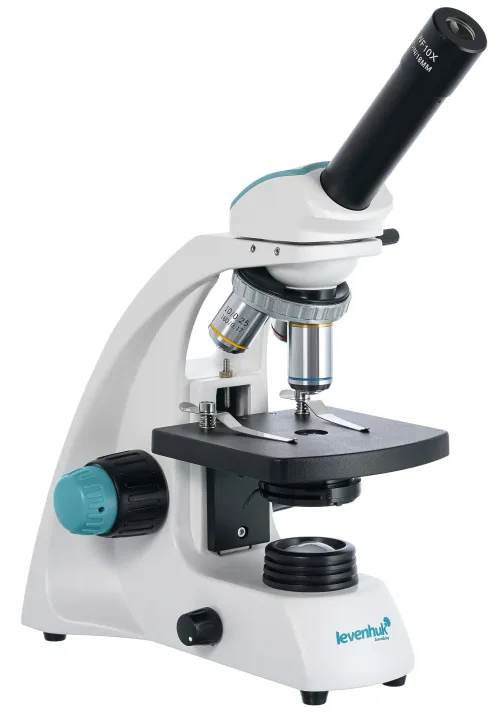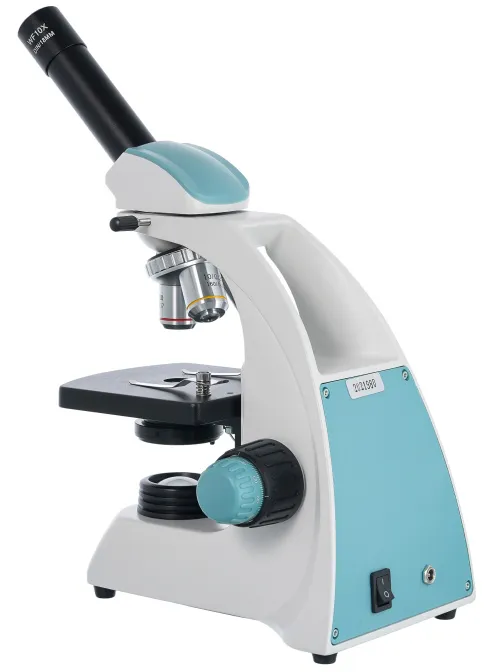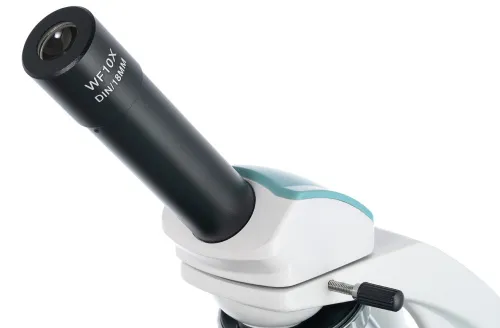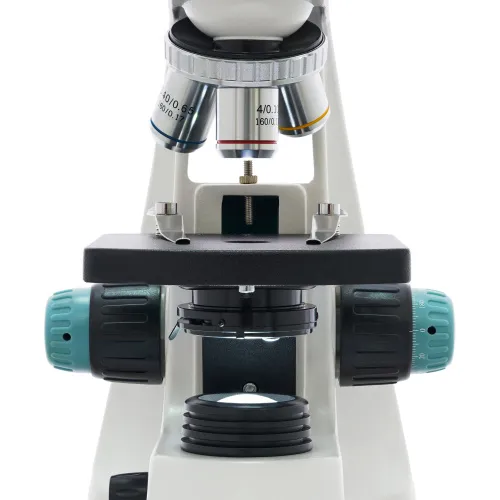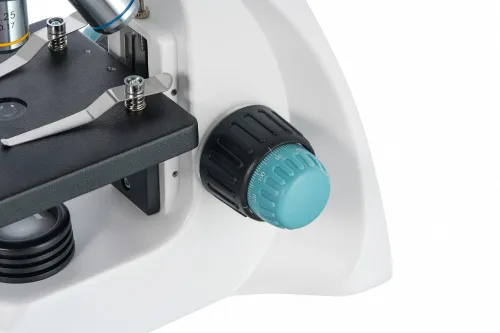Levenhuk 400M Monocular Microscope
Magnification: 40–400x. Monocular head, achromatic objectives, LED light with a collector
| Product ID | 75419 |
| Brand | Levenhuk, Inc., USA |
| Warranty | lifetime |
| EAN | 5905555005249 |
| Package size (LxWxH) | 40x19x27 cm |
| Shipping Weight | 2.88 kg |
Levenhuk 400M Monocular Microscope is designed for conducting laboratory research on biological samples. It delivers a sharp and contrast image and allows for observing samples at magnification from 40x to 400x. This microscope can also be used in medical, educational, and research institutions. The microscope features a built-in LED light that works on batteries or via an AC power supply.
The optics are based on a wide-field eyepiece and achromatic objectives of various magnification. Overall magnification of an optical system allows for working with medium and large structures. The monocular head is conveniently inclined at 45° and is 360° rotatable. A microscope is excellent to use for individual and group work as well.
The stage is equipped with two holders; right underneath there is an Abbe condenser with an iris diaphragm. You can install light filters in a special holder (the kit includes a blue, green and yellow light filters). A standard coaxial mechanism is used for focusing. There is fine and coarse focusing adjustment available.
A lighting system consists of an LED light with a collector. It is located at the bottom of the microscope. The lighting features adjustable brightness. Due to battery-powered operation, Levenhuk 400M is mobile and can be used even in places without access to electricity.
The body is made of metal: therefore, the microscope is reliable and has a long service life.
Features:
- Rotatable monocular head inclined at 45°
- Magnification: from 40x to 400x, achromatic optics
- Lower LED light with brightness adjustment
- Power supply is variable: by batteries or AC power supply
- Metal body, standard eyepiece barrel diameter
The kit includes:
- Microscope
- 4x, 10x, 40xs achromatic objectives
- WF10x/18mm eyepiece (1pc.) with a pointer
- Condenser N.A. 0.65 with an iris diaphragm and a filter holder
- Charging power cord
- Filters: blue, green, yellow
- Dust cover
- User manual and lifetime warranty
| Product ID | 75419 |
| Brand | Levenhuk, Inc., USA |
| Warranty | lifetime |
| EAN | 5905555005249 |
| Package size (LxWxH) | 40x19x27 cm |
| Shipping Weight | 2.88 kg |
| Type | biological, light/optical |
| Microscope head type | monocular |
| Optics material | optical glass |
| Head | 360 ° rotatable |
| Head inclination angle | 45 ° |
| Magnification, x | 40 — 400 |
| Eyepiece tube diameter, mm | 23.2 |
| Eyepieces | WF10x/18mm (1pc.) with a pointer |
| Objectives | achromatic: 4x, 10x, 40xs (spring) |
| Revolving nosepiece | for 3 objectives |
| Stage, mm | 110x110 |
| Stage moving range, mm | fixed |
| Stage features | with clips |
| Condenser | N.A. 0.65 with an iris diaphragm and filter holder |
| Diaphragm | iris |
| Focus | coaxial, coarse (12mm) and fine (0.002mm) |
| Body | metal |
| Illumination | LED |
| Brightness adjustment | ✓ |
| Power supply | 110–220V, via AC adapter (included), 3 AA batteries (not included) |
| Light source type | with a collector, 1W LED |
| Light filters | blue, green, yellow |
| User level | beginners, experienced users |
| Assembly and installation difficulty level | easy |
| Application | school/educational, laboratory/medical |
| Illumination location | lower |
| Research method | bright field |
| Pouch/case/bag in set | dust cover |
We have gathered answers to the most frequently asked questions to help you sort things out
Find out why studying eyes under a microscope is entertaining; how insects’ and arachnids’ eyes differ and what the best way is to observe such an interesting specimen
Read this review to learn how to observe human hair, what different hair looks like under a microscope and what magnification is required for observations
Learn what a numerical aperture is and how to choose a suitable objective lens for your microscope here
Learn what a spider looks like under microscope, when the best time is to take photos of it, how to study it properly at magnification and more interesting facts about observing insects and arachnids
This review for beginner explorers of the micro world introduces you to the optical, illuminating and mechanical parts of a microscope and their functions
Short article about Paramecium caudatum - a microorganism that is interesting to observe through any microscope

